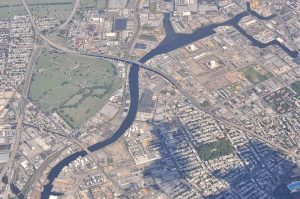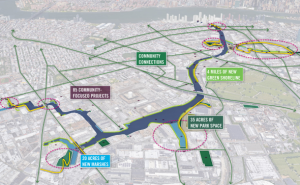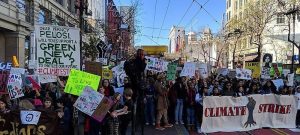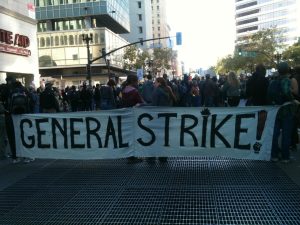Where Next for the US Environmental Movement?
The next step for the movement should be a Campaign for a National General Strike.
We are living in the midst of the Sixth Mass Extinction due to human-caused climate change and environmental destruction. How can we heal Mother Earth and live in harmonious coexistence with the natural environment? The efforts of local scientists and community members nearby Newtown Creek provides us a glimpse of what such efforts can look like on the local level.
Newtown Creek is a 3.5 mile long estuary that forms part of the border between the boroughs of Queens and Brooklyn in New York City. According to a 2018 study and vision plan released by Riverkeeper and the Newtown Creek alliance, the creek is designated as a Significant Maritime and Industrial Area (SMIA). Industries along the creek move over a million tons of freight by barge every year. The creek’s waterfront is almost entirely industrial, with the mouth of the creek being the only exception. It is one of the most heavily used and polluted industrial sites in the United States. The creek used to be home to multiple oil refineries and was the site of the infamous Greenpoint oil spill, one of the largest oil spills ever recorded in the United States.

Newton Creek Aerial View (Creative Commons)
Ecologically, the creek is part of the larger estuary system of the New York Harbor, and once teemed with wetlands, marshes, and sea grasses. Over time the creek and its surrounding land became highly industrialized, with miles of pavement, impermeable surfaces that lead from the water’s edge to several blocks upland, multiple highways and bridges, alongside dense new developments, new infrastructure, and new zoning plans. Industrialization, in addition to the destruction of wildlife and the creek’s ecosystem, also destroyed the natural storm surge protections of the creek. The surrounding area also has an antiquated sewage system, where the storm drains are connected underground with the sewer pipes coming from homes and businesses, which leads to common rainfall exceeding the sewer’s capacity, overflowing, and discharging directly into the creek. Up to 1.2 billion gallons of discharge (with raw sewage, oils, litter, and many other pollutants) can enter Newtown Creek every year.
The effects of climate change have escalated this danger. In 2012, Hurricane Sandy brought with it an excess of rain and winds which pushed solid waste and hazardous materials into the surrounding community, alongside the building warehouse, and facility damage. As water levels rise and irregular storm patterns continue to develop, these issues will become more and more pronounced.
In order to transform the creek to serve the needs of the community, Riverkeeper and the Newtown Creek Alliance, two environmental non-profits, worked together to develop a vision plan. They set up a series of meetings and invited community leaders, local organizations, students, to collectively plan for the project, which resulted in their vision plan.

Proposed Revitalization of the Creek (Source: Newtown Creek Vision Plan)
The head of the creek will be transformed into a public park and help provide boating access to small crafts like canoes and kayaks. Green Roofs will be added throughout the creek, especially on top of industrial buildings for storm water controls. New waterfront edges will be added throughout much of the creek which will be filled with wildflowers and indigenous plants. Roadways will have added capture facilities alongside filtration systems underneath bridges and overpasses. Oysters and mussel habitats will be created throughout the creek to aid with water filtration. Public overlooks, art opportunities throughout the creek, educational centers and new walkways and bike lanes will be added to transform the creek into a public space for the education and enjoyment of the community and visitors. A portion of the creek will be made into a wetland conservancy. The combined effect of all of these proposed changes will be to create a creek system that is far more resilient to storm surges, serves the needs of the community, and also preserves natural wildlife.
However, despite the numerous social benefits to the revitalization of the creek, there are significant hurdles. According to Willis Ekins, the executive director of the Newtown Creek Alliance, biggest obstacles include funding, logistics and lack of ‘buy in’ from city agencies and stakeholders. Some city agencies “basically don’t seem super interested in pursuing a vision of creating our space,” he says.
Construction for the project relies on grants and funding from the NYC government, especially the parks department, as well as donations from private contributors. Groups like Newtown Creek Alliance are in perpetual search for funds, from a variety of sources, in order to advance essential social projects such as this. It’s been over 5 years since this plan was released and there is no definite end-date for when the project will be completed. While projects like this are crucial for protecting residents of the city from the effects of climate change and sea level rise, the NYC parks department received only 0.6% of the city budget, with a total of $624 million allocated to the agency’s operations. In contrast, the NYPD received 9 times that amount with a yearly budget of $5.59 billion.
It is clear that the city desperately needs community engagement and mass investment into plans which serve the common good. Newtown Creek Vision Plan clearly fits the bill. Yet, drive of private capital to continuously enrich itself is consistently undermining it.
In the Flushing Bay for example, a large real estate project called the Special Flushing Waterfront District was approved by the NYC City Council in December 2020 with construction expected to be completed by 2025. According to the Flushing Bay Guardians, a conservancy group in the area, the 29-acre district, composed of 13 towers, 1,725 luxury condos, and only 61 affordable housing units, will “add over 1,000 new sewage connections to an overburdened Flushing Creek, which receives over 1 billion gallons of raw sewage and polluted stormwater every year” and would “create economic barriers to waterfront access and will destroy a 40-year old forest, which would have vast impacts on the 13-year old wetland on the opposite bank.” Development projects such as this–driven by mega-real estate and financial institutions–with little regard for its environmental consequences and damage to community members, are common throughout the city.
The problems that environmentalists face on a local level, .i.e. capitalist schemes undermining progressive plans and lack of state support for initiatives that serve the common good, also exist on the national level.
The Green New Deal
The environmental struggle on the national level has taken the form of the struggle for the Green New Deal. The Green New Deal has been recently popularized by the Sunrise Movement which was launched in 2017 with its roots going back to efforts by young climate activists in the few years prior. The movement’s founders were mostly trained by Momentum, an organization focused on teaching community organizing. It itself had been founded in 2014 by labor, environment and immigrant rights organizers as well as veterans of the Occupy movement. Many of the Sunrise Movement’s founders were previously part of mainstream climate organizations like Sierra Club and 350.org.
William Lawrence, one of the leaders of Sunrise in its early development, detailed their strategy as:
- Change public sentiment and create political urgency through the use of moral protest and direct action
- Create space for our ideas in federal politics by aligning with progressive faction of the Democratic Party
- Cohere a new, multiracial, cross-class majority for climate action
Sunrise has rapidly grown since its founding in 2017. It now boasts thousands of members and a series of over 400 local teams called “hubs”. Sunrise’s leadership and national strategy is not democratically decided by its members, which is a point of contention. The funds are distributed by the national leadership of the organization, though the local hubs have great autonomy to pursue various tactics.
In 2018, Brand New Congress and Justice Democrats, two organizations which were founded by staffers of Sanders 2016 campaign, and which shared the strategy of Sunrise of realigning the Democratic Party, ran their campaigns to remake Congress and had their most significant victory with the election of Alexandria Ocasio-Cortez (AOC). The Green New Deal was a cornerstone of her campaign.
AOC won an upset victory, alongside Democrats Ilhan Omar, Rashida Tlaib, and Ayanna Presley, all of whom were endorsed by Justice Democrats/Brand New Congress. With AOC and Rashida, DSA now had two members in the Congress which helped with a huge surge in membership. After her victory, on November 13th, AOC joined a sit-in with 150 youth activists organized by the Sunrise Movement at Nancy Pelosi’s office, demanding immediate action on climate change. A month later, Justice Democrats and the Sunrise Movement met to craft the Green New Deal.
In February 2019, AOC and Senator Ed Markey (a Democrat who Sunrise had helped get elected), introduced the Green New Deal. The deal called for a 10 year mobilization plan to get to net-zero emissions by 2050, by huge investments in clean energy and tied climate demands to labor demands, calling for a federal jobs guarantee. The bill had over 100 co-sponsors and its purpose was to be debated in Congress with the goal of creating concrete laws to address the climate crisis. The next month, this “non-binding resolution” was killed in the Senate by Republicans.
A global mass protest was organized in September 2019 by a huge number of environmental organizations, including Sunrise. In the US there were over 1000 events planned in all 50 states, with the demands centered on passing the Green New Deal.

2019 San Francisco Youth Climate Protest
As campaigns for the 2020 election kicked off, Sunrise continued to hold protests, with activists sleeping on the steps of the DNC office in Washington DC to protest the lack of focus in the Democratic Primary debates on the climate crisis.
Bernie Sanders’ 2020 campaign, endorsed by Sunrise, pushed forward the Green New Deal Platform as a cornerstone of the campaign. It called for a $16.3 trillion dollar investment to, among other plans, fully electrify and decarbonize the transportation sector, establish nationwide materials recycling programs, invest in the Green Climate fund, replace the nation’s water systems, and increase funding for roads, alongside a commitment to use the investments to build “good union jobs.”
The Sanders campaign started strong, winning the Iowa caucuses and the New Hampshire primary. By February, it emerged as the national front runner. But the Democratic National Committee laid down the hammer to destroy Sanders. Right before Super Tuesday, front runners Pete Buttigieg and Amy Klobuchar dropped out and endorsed Biden while the “progressive” Elizabeth Warren remained and in effect siphoned votes away from Sanders. Biden won the majority in March’s Super Tuesday and the media establishment rushed to boost him and diminish Sanders, going so far as to spread a conspiracy theory that Russia was actively supporting him, a claim repeated by publications like the New York Times, Wall Street Journal, and Washington Post. After Biden established a commanding lead by April, Sanders formally suspended his campaign and endorsed Biden.
The Sunrise movement alongside Justice Democrats/Brand New Congress reoriented itself to support the Biden campaign as part of the Biden-Sanders Unity Taskforce. The joint task force on climate change was co-chaired by AOC and it counted Varshini Prakash the executive director of Sunrise, as a member. In its recommendation, the task force agreed with the Green New Deal demand of net-zero carbon emission by 2050 and called for increases in investment in renewable energy and conservation efforts.
The concrete result of this partnership with the Biden administration was the introduction of Build Back Better (BBB), dubbed as Biden’s version of a “Green New Deal”, in mid-2020. A study by Moody’s Analytics showed that the plan would cost $7 Trillion, with an increase in tax revenue of $4.1 Trillion from corporations and the wealthy, which would be used for investments in domestic manufacturing, education and healthcare, and over $2 trillion in clean energy investments. It also included trade protections aimed at countering the growth of China.
Biden took office under a split congress and soon proposed splitting up BBB in order to increase its odds of passage. On March 31st, he released the American Jobs Plan, which included $885 billion in climate investments, far lower than what he had promised in his campaign. In a back and forth which took months, the modest proposals from BBB were cut down and reduced by staunch opposition from the Republicans and key Democrats like Joe Manchin and Kyrsten Sinema. On September 27th, the Build Back Better Act was finally introduced to Congress, further reducing proposed clean energy investments to $555 Billion. On December 19th, despite further reductions to BBB, Manchin announced that he would not vote for the bill, effectively killing it.
Renewed negotiations began July 2022, with Manchin and Chuck Schumer announcing the final version of BBB, the $790 Billion Inflation Reduction Act on July 27th. Climate investment was further cut to $386 billion. However meager, the bill will help increase renewable energy efforts but it does far too little to accomplish the 2050 target of net zero emissions, and further is tied to major concessions such as the removal of punishments for emitters and, as one report puts it ”requires that the government auction millions of acres of oil and gas leases before it can auction acreage for wind and solar farms.”
Sunrise had desperately organized protests throughout 2021 concentrating their energy into the passage of BBB. They went on hunger strike outside the White House, launched protests outside of Schumer’s office, and Manchin’s houseboat. At that stage, their protest strategy did not make a dent.
A Possible Way Forward for the US Environmental Movement
At present the environmental movement is at an impasse and faces an increasingly weaponized US government. Since the 2022 midterms, with the composition of the Senate remaining basically unchanged, the House is under the control of the Republican Party, who have plans to expand oil drilling and cut climate provisions from the Inflation Reduction Act. This year, the environmental regulations passed under Biden will face the fire of a Supreme Court, dominated by Republican appointed judges.
Sunrise’s fundamental assumption was that transformative change was only possible within the US legislative system, but without substantive power outside of the US government, the environmental movement has no leverage as concessions and attacks from corporations and the US government take place. Matt Huber advances the idea of building power outside of the US government in Jacobin by arguing that the environmental movement needs to form stronger ties to the labor unions as the only real means of connecting with the working class. Multiple unions have already endorsed the Green New Deal but it is not enough to gain endorsements and paper statements of support. When faced with the might of the US state, as was the case with the recent struggle of rail workers, the large labor unions and their bureaucracies were unwilling to build up strike support and organize solidarity rallies in support of rail workers. They merely looked on as Congress moved to crush the rail workers demands for paid sick leave. The unions must be willing to go on strike to back up their paper support.
Environmentalists will need to appeal directly to the working class. The bulk of environmental conservation efforts takes place on a local level as illustrated by the study The Broader Movement: Nonprofit Environmental and Conservation Organizations, 1989-2005. The local environmental groups, such as Newtown Creek Alliance, have been able to create transformative plans, concretely showing locals how their environment can be shaped to better serve their well-being.
Groups like DSA and the Sunrise Movement can team up and build links with local scientists to create transformative planning efforts, conduct mass door knocking and run outreach operations in local communities. This is the path gaining support for plans which will reforest the suburbs, breathe life into the urban sprawl, repopulate local wildlife, create mass public spaces and offer environmental education for the masses.
Through a merger of science and the workers’ movement, environmental change can be framed not just as building more renewable energy sources, but as a project of radical beautification of our communities, our cities, our country, and our planet.
This local outreach must be connected to a strategy of developing an independent political center of the oppressed which can help connect environmental justice to all of the struggles faced by that working people. The Sunrise Movement was rooted in the Occupy Wall Street Movement, which had tied the environmental struggle to a struggle against the 1% of wealth holders. The Occupy Wall Street movement should be revived on a much higher foundation. We should remember that it were not the labor unions, tied to contract language and legality, but Occupy Oakland which was able to successfully call the country’s first general strike in 65 years in which the unions followed and thousands of workers participated, shutting down a port.

Occupy Oakland General Strike (Wikimedia Commons)
Occupy was able to grow and shift political consciousness because it was a dramatic organized action that captured the mood of the people at the moment and allowed for all to join its ranks. It was crushed because it was decentralized, lacked a definite goal, and was unable to develop a mass organization.
As we head into the 2024 elections, a new mass movement must arise. The form it must take is a Campaign for a National General Strike. Environmental groups, socialist groups, unions, and all of the fighting layers of the oppressed should unite to formulate a simple list of demands and set a date for an indefinite general strike till those demands are met. Only in this way can we prevent co-optation from the Democratic and Republican parties.
In order to popularize the demands and build the capacity for the general strike, mass rallies should be held in every major city and petitions should be spread, communications should be developed allowing for an ease of joining the organization, and democratic strike committees and democratic national organization should be created to coordinate and plan for this day of action, showcasing by mass force what the working people and oppressed of the country want and need. While a movement such as this will not by itself solve the question of what class is to wield political power, what it will do is create an independent center of power for the oppressed that can be used to radicalize the minority organized in unions as well as the unorganized majority. It will serve as a battering ram to force through the changes that the working people need now.
While some may scoff, the author would like to remind them that the energy for mass general strike exists, lest we forget the insurrectionary action that took place in 2020 with the largest and greatest protest wave in world history. Conditions have only gotten worse since then. It is time to spark the dynamite of discontent brewing among the working people and oppressed of this country into a great mass movement that will bring forward the revolutionary changes needed to heal ourselves, our communities, and our planet.
 Democratic Socialists of America
Democratic Socialists of America